
 School of Drums
School of Drums
There are 65,536 possible variations of the 4th-Note Rock Beat, depending on the tempos. The average drummer
will normally memorize and develop only about 15 of them to top
speed. The Worlds BEST drummers are probably using only a few more than that.
Don't worry about the awesome 65,536. Many of
those permutations are non-functional because they tend to reverse the
polarity of the backbeats. Others are virtually impossible to play
for us lowly, single-brained humanoids.
We will be focusing on the MOST IMPORTANT
'easy' beats in this lesson. Later on, when you get into permutation theory ,
a VERY BIG picture will form in your minds eye. You will easily understand these,
and zillions of others of the remaining 'modified time signatures'. Learning to play them
ALL might require several lifetimes. Remember! We are all, 'ONLY' human. There will be limits as to how fast we can play these patterns. Start at a very, very
s l o w speed with each idea and build gradually, over a period of 20 or 30 minutes practice (with each pattern). This is the most basic form of Basic Dancebeat #5, the Quarter-Note Rock Beat.
VARIATION #1: VARIATION #2: VARIATION #3 Hopefully you will begin to see that manipulating extreme speeds and blazing tempos becomes a matter of logic.
We need to recognize the fact that there are limits to how fast the hands and feet will move. As tempos increase, we're bound by those limitations,
no matter how we strive and struggle to push the envelope. The solution to extreme tempos and speeds is to keep it real. We must understand
that we simply can't do as much as tempos increase. To play faster tempos actually means we must . . . do less. As song tempos go totally berserk, we may be forced to resort to using 'Half-note Rock 4/4' as a way to
keep up with the music. The recent 'youth market' (Punk, Headbanger, etc., etc.) music styles seems to be demanding those berserk
tempos. So, if you are into the extremely fast-tempo music styles, you'll be needing this knowledge. The reason I don't have a specific lesson on Half-note 4/4, 32nd-note
4/4 and some of the other existing primary dancebeats is the fact that they are so rarely used. I also know you will understand them
easily as the music you encounter calls for them. (So now, I must admit that I lied.) There are more than just 5 Basic Dancebeat structures.
If you'll remember though, I said that 98% of all music is based within the big 5. Half-note 4/4, 32nd-note 4/4 (and a few others) belong in the
final 2% category. So, it wasn't really a lie; it just seems prudent to not mention them until there is a need to do so. Also be aware that as you play these extreme tempos you will also want to inject all the fills into the music as well. Nearly
all the classic note-value fills we've studied will fit within these tempos as well. Their note-value names
will change but the fills will feel and sound nearly the same as they did when we applied them to 8th 'rock' 4/4. Yes! This is difficult. Take heart beginners. You will gain these speeds gradually as you continue playing and
jamming with all the slower music styles. Don't get spooked if you can't do all this as rapidly as you would like. It will come with time. Once you have these few patterns cooking . . . try playing them end to end, and mix them around. You should begin to
realize that your are beginning to sound a lot like some of your favorite monster players! After that, get the creative juices
flowing. Imagine other configurations of the bass/snare within this framework (or signature modification). There is plenty I haven't
covered here. I KNOW you will get the rest as you listen and jam with more music within this vein. It will also come to light as you study
Finite to Infinity. Since these beats are geared for quick tempos you may find it difficult to cram in the complex rolls at first. Don't panic! Just keep playing and
keep doing what you can do. Video: For almost all handheld devices and other browsers. Each of the above patterns is one full measure of Quarter-note 4/4 . . .or (street name) 'Quarter Rock'. Any measure of any
song can 'technically' be different than the one before it (theoretically). Wild drummers tend to take advantage of the theoretical rule,
where most 'generic' drummers tend to play one or two permutation patterns repetitiously . . . all the way through a song. This
sounds like pretty lame or simplistic philosophy, from a drummer's perspective . . . but there are BIG and IMPORTANT reasons for playing
the simple and boring 'generic' way. Hint: Over-playing tends to often offend the other musicians within the band. They may throw us a
squinting 'fisheye' if we choose to over-play. In other words, if we hog the show it sometimes means that they may need to quit expressing themselves
rhythmically and musically. It means we're asking them to step-back while we steal their limelight. This may not set well with
all the musicians you will meet. Some will fight you for the glory and their fair share of the limelight. It is a debate that has been raging for years. See the online lesson, 'How to beat the Monster
Drummers to the Dream Gigs' . We'll touch on
this subject a little there. Also; here's another web-page that delves into the same topic a bit more. You must decide and live-with
your own philosophies, but it is good to be fully aware of both sides of the (Simplicity VS Creativity) issue. The secret to becoming a killer drummer is a matter of dedicated and persistent practice mixed with a heavy diet
of jamming fun. So, learn little bites of new knowledge, one bite at a time, then adapt the new info into your own playing
style gradually, by jamming with recordings for hours. The objective is to make each morsel of new knowledge, a part of
your daily jamming routine! Try to devote about three hours to the above beat patterns. It may seem boring at first! The boredom factor tends to
make it difficult for many students to realize the value. Practice the 'boring' routines in your easy chair while you watch TV, or
at the computer while you wait for web pages to load. This will help make the studious routine more
enjoyable. A few days later, your ability as you jam with recordings, will surge to new levels. Musical Time - Finite to Infinity: Finite to Infinity: Discover the (lost) 500 year-old enigmatic secrets hidden within
the current time-signature system. Seven short mesmerizing and easy-to-follow lessons will lead you quickly and easily towards
(musical-time) guru status. You will learn to visualize (read, write or feel) the existence This should lead
directly to the e-book. This very informative little booklet will amaze you
with hundreds of valuable tips and insider secrets! HOW TO: Purchase old/used drumsets for pennies and resell them for decent
profits.
![]()
![]() Drums: Understanding Extreme Tempos
Drums: Understanding Extreme Tempos![]() 4th-Note 4/4 'Rock Beat' Variations
4th-Note 4/4 'Rock Beat' Variations
![]()
![]()
4th-Note (or Quarter-Note) 4/4 'Rock Beat' Variations (Permutations):
![]() Try These Ideas
Each of the following (song beat) variations should be memorized and developed to maximum speed.
Try These Ideas
Each of the following (song beat) variations should be memorized and developed to maximum speed.
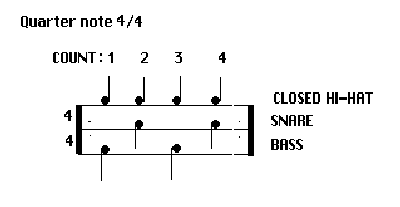
Begin slow & gradually build speed. That quick second bass is syncopated
'in-between' the cymbals. If you've mastered Bass syncopations already, this
should seem easy. 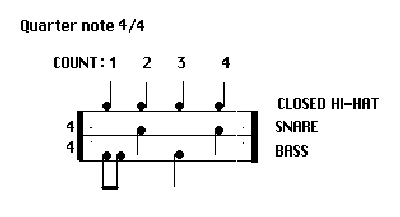
![]() Try playing along as you listen to it.
Try playing along as you listen to it.
This is the same idea used differently. It will produce a different rhythm.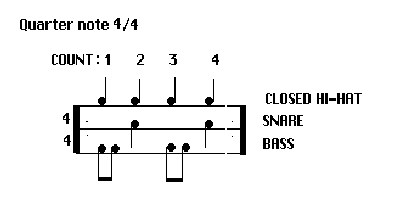
Now we are doing essentially the same thing on the snare.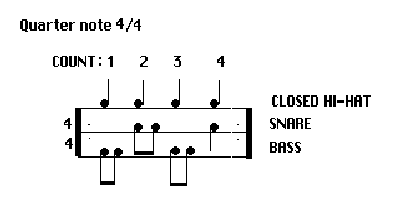 VARIATION #4:
VARIATION #4:
This next variation is one of the most popular Quarter Rock variations. It
is really a quarter-note form of the 'Fatback #1' (song-beat) pattern we studied in the previous lesson. The difference is,
we're now eliminating half the cymbal notes. With the elimination of those cymbal (hi hat) notes we discover that we can now play the patterns
at near double the tempos. All four of those Fatback patterns we learned in the previous lesson can and should be studied this same way, with
Quarter-notes on the hi hat.
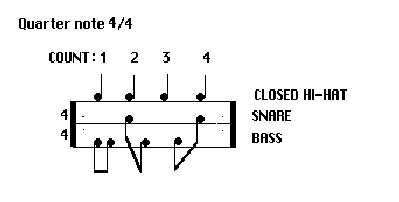
![]() Hear all of them back to back.
Hear all of them back to back.![]() Here is the Quarter-note Fatback beat with an added Single stroke Fill. Also try double-strokes, paradiddles, triplets, crushes and every
fill or fill combination you can play. Keep the primary tempo steady and go crazy with fills and beat variations if you can.
Here is the Quarter-note Fatback beat with an added Single stroke Fill. Also try double-strokes, paradiddles, triplets, crushes and every
fill or fill combination you can play. Keep the primary tempo steady and go crazy with fills and beat variations if you can.![]() VIDEO: Click here to 'Play', see, and hear the this entire lesson. (This video is designed for Internet Explorer using Windows Media Player.)
VIDEO: Click here to 'Play', see, and hear the this entire lesson. (This video is designed for Internet Explorer using Windows Media Player.)
![]() Copyright Bill Powelson 1965-1994-2008-2014 @ all rights reserved.
Copyright Bill Powelson 1965-1994-2008-2014 @ all rights reserved.![]()
![]()
Cool Drum Solos.
Video Drum Solo Lessons Free

Drum Solo Video: Click to 'LEARN' Watch and Learn Now! PLAY Great Drum Solos within hours (not years).
NEW 'Subliminal Method' teaches drum solo techniques PAINLESSLY!
Master rudiments 'NATURALLY' without boring regimentation or serious discipline.
Listen, watch and PLAY your way to awesome drum solos (and polished rudiments) BY SIMPLY HAVING FUN. . . . It works, folks!
Don't be a skeptic until you at least try it first. You owe it to yourself toTRY IT RIGHT NOW!
![]()
![]()
Membership Includes
EVERYTHING FREE! All the E-book icons are "hot" here at the password site. Click an e-book icon and go directly to the product.
Bill Powelson's Other Drumming Courses
![]()
